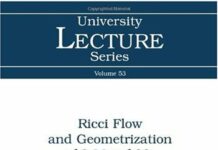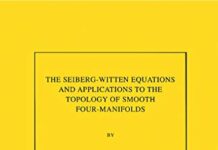
Ebook Info
- Published: 2014
- Number of pages: 130 pages
- Format: PDF
- File Size: 0.82 MB
- Authors: John W. Morgan
Description
The recent introduction of the Seiberg-Witten invariants of smooth four-manifolds has revolutionized the study of those manifolds. The invariants are gauge-theoretic in nature and are close cousins of the much-studied SU(2)-invariants defined over fifteen years ago by Donaldson. On a practical level, the new invariants have proved to be more powerful and have led to a vast generalization of earlier results. This book is an introduction to the Seiberg-Witten invariants. The work begins with a review of the classical material on Spin c structures and their associated Dirac operators. Next comes a discussion of the Seiberg-Witten equations, which is set in the context of nonlinear elliptic operators on an appropriate infinite dimensional space of configurations. It is demonstrated that the space of solutions to these equations, called the Seiberg-Witten moduli space, is finite dimensional, and its dimension is then computed. In contrast to the SU(2)-case, the Seiberg-Witten moduli spaces are shown to be compact. The Seiberg-Witten invariant is then essentially the homology class in the space of configurations represented by the Seiberg-Witten moduli space. The last chapter gives a flavor for the applications of these new invariants by computing the invariants for most Kahler surfaces and then deriving some basic toological consequences for these surfaces.
User’s Reviews
Reviews from Amazon users which were colected at the time this book was published on the website:
⭐On the whole, I think Morgan does a good job of getting to the point. The book is no more than 130 pages. He lingers on Clifford algebras and spin groups just long enough to look at specific examples in 4-dimensions. From there, he gives a brief discussion of principal-G bundles and some basics of covariant derivatives, curvature, and spin bundles. The goal of chapter 3 is to define the Dirac operator. Ch. 4 introduces the Seiberg-Witten equations and ch. 5 shows how we obtain some a priori bounds automatically from the curvature equation. This is vastly important as we then obtain compact moduli spaces. In ch. 6, we see that for generic perturbations of the equations, the moduli spaces are in fact smooth manifolds (we “resolve” singularities in this way). We also finally see how the Seiberg-Witten invariants are defined and why they are independent of the Riemannian metric. Indeed, they are an orientation-preserving diffeomorphism invariant. Lastly, in ch. 7, Morgan computes the invariants for various Kahler surfaces.The book was written quite early on in the development of Seiberg-Witten theory and thus, Morgan intended his audience to be those thinking about gauge theory in Donaldson’s work. As such, the book may be difficult for those not well-immersed in differential geometry. “Spin Geometry” by Lawson and Michelsohn is a helpful companion as are Morgan’s notes in “Gauge Theory and the Topology of Four-Manifolds.”One wish I have is for the book to discuss some of the useful results such as the blowup formula or theorems about connected sums. I would also like more applications towards almost-complex surfaces and symplectic manifolds, and even a proof of Donaldson’s diagonalization theorem using Seiberg-Witten theory.
⭐This was the first book published on Seiberg-Witten gauge theory in 1996 (but written in early 1995). As such, while it gives an introduction to the field, it doesn’t include any of the multitude of results and extensions discovered since then, so this would hardly be suitable as a reference on the subject that would allow one to understand current research. On the other hand, Prof. Morgan was mainly writing for mathematicians who were familiar with the older Yang-Mills/Donaldson gauge theory, so he doesn’t explain the techniques and motivations behind many of the proofs that a beginner in gauge theory would fail to grasp.There have been 4 books (that I’m aware of) devoted to SW gauge theory – this one, John Moore’s
⭐, Nicolaescu’s
⭐, and Marcolli’s
⭐. Morgan and Moore’s books came out at about the same time and largely cover the same material, whereas Marcolli and Nicolaescu’s works came 4-6 years later and encompass much more of the breadth of the field. But having said that, each book has some advantages over the others and none could be said to be strictly better than any other in all respects. The advantages of this book are that (1) it is relatively concise (126 pg),as compared to Nicolaescu, which rambles, (2) it contains a complete proof of the properties of the moduli space that one needs to define invariants (unlike Moore) and gives much more detail than Marcolli, (3) it proves results in more generality than Moore, and at a higher level, with at times more insight, and also includes some results that Moore omits, and (4) it explains the background material on Clifford algebras, spinor bundles, and Dirac operators much better than Marcolli. The disadvantages are that, as mentioned above, (1) this includes only results from Witten’s original 1994 paper (fleshed out and proved rigorously), (2) Morgan is implicitly assuming that the reader has some knowledge of YM gauge theory as can be found in, e.g., Freed and Uhlenbeck’s
⭐, and (3) more knowledge of algebraic topology, Sobolev spaces, differential geometry, the index theorem, etc., is assumed than is the case for Nicolaescu or Moore.For those unfamiliar with Seiberg-Witten gauge theory, or mathematical gauge theory in general, I’ll give a brief introduction. Gauge theory (in mathematics) is the study of the spaces of solutions to certain differential equations on sections of bundles over a given manifold that originally came from gauge theory in physics. The space of such solutions modulo automorphisms of the bundles (the group of gauge transformations) is called a moduli space. Gauge theory consists in a set of techniques used to study these moduli spaces and prove that under appropriate conditions on the underlying manifold the moduli spaces have various properties, such as, smoothness, compactness, finite-dimensionality, and orientability. If a moduli space possesses all these nice properties, one can define smooth invariants for the underlying manifold that allow one to study its differential topology. The first equation for which this was done was the Yang-Mills equation, the fundamental equation of particle physics, for which Donaldson won a Fields Medal for his work in the ’80s in defining the invariants that bear his name and applying them to the study of the smooth topology of 4-manifolds. The proofs in this field tend to be long and very technical, requiring a broad background in differential geometry, emphasizing in particular principal bundles, nonlinear and functional analysis, particularly Sobolev spaces and elliptic operators, Lie groups and algebras, some complex analysis, index theory, and algebraic topology, including characteristic classes, so it usually takes a couple of years for graduate students to master the material necessary to even begin studying the field. The Seiberg-Witten equations, which were introduced in 1994, had some properties (namely, an abelian gauge group U(1) and compact moduli spaces) that allowed the proofs in Donaldson theory to be derived with far less effort, thus revolutionizing the field.This book was written immediately after Witten (who also won a Fields Medal, in part due to this work) published his groundbreaking paper that launched the field and led to an explosion in results on smooth and symplectic 4-manifolds in the span of a couple of years. I was just entering graduate school in math at the time (having switched from physics) and Prof. Morgan was my new advisor. There was a lot of excitement in the air and a rush to be the first to publish on this new field, so when he wrote this book, he had more in mind an audience of mathematicians who were already familiar with the old Donaldson theory and wanted to apply the techniques they had learned to the new SW theory. Consequently, the book is careful to develop the Clifford algebra and spinor theory that is the new feature in the SW equations, but doesn’t spend much time explaining things such as the rationale behind the method of proof for transversality or the fact that the configuration space is a Banach manifold since those techniques had already been developed for the YM gauge theory. Nowadays any mathematics student learning gauge theory for the first time is likely to start with SW theory, or both simultaneously, so few students fit the profile of the intended readership of this book. I also have to confess that Prof. Morgan was one of the most difficult lecturers to understand that I have ever come across, and he sometimes writes that way, too, as he demands a lot from the reader, as one can see from some of his asides, e.g., on the homotopy type of the quotient space, or his proof of the existence of liftings for Spin-c bundles.Chapters 2 and 3 form a nice introduction to Clifford algebras, spinors, and Dirac operators. A good reference for more detail (and also the index theorem) is Lawson and Michelson’s
⭐. Then the Seiberg-Witten equations are introduced in Chpt. 4 and properties of the equations (gauge invariance and ellipticity on slices), quotient space (smoothness away from reducibles and Hausdorffness, missing in Moore), and moduli space (it’s formal dimension) are proved. In Chpt. 5 more background on curvature identities for spin connections is presented and then applied to prove the a priori bounds that are one of the biggest advantages of SW theory over Donaldson theory. This immediately leads to the vanishing theorem and a proof of compactness, without assuming simply connectedness as Moore does. Morgan’s boot strapping argument for compactness is needlessly complicated, involving more Sobolev inequalities than is really necessary – Moore’s and Nicolaescu’s proofs are much more streamlined. In Chpt. 6, perturbations are introduced to the equations allowing the Sard-Smale theorem to be applied to achieve smoothness for “generic” moduli spaces, which are also shown to generically lack reducible solutions (although Morgan appeals to a result of Taubes; see Marcolli for a simpler, self-contained explanation). Compactness is then reestablished for the perturbed moduli spaces (this should’ve been organized better to avoid having to prove compactness twice), a generic metrics theorem is proven (missing in Moore), and finally the moduli space is shown to be orientable (probably the most boring part of any gauge theoretic proof), giving all the ingredients necessary to define the Seiberg-Witten invariants (it only took 99 pages!), the purpose of the book. The chapter concludes with some more advanced topics (an involution in the theory and a wall-crossing formula) that Moore lacks.The final chapter calculates the Seiberg-Witten invariants for various Kaehler manifolds. However, these computations are not actually used to derive any results about the topology of smooth 4-manifolds, so the title of the book is misleading, although the application of these results is straightforward (i.e., if 2 manifolds have different SW invariants then they are not diffeomorphic). The final paragraph of the book mentions the work of Taubes in connecting SW invariants to symplectic geometry and Gromov invariants that became the focus of the theory over the next few years (no mention of this in Moore, but not that much on it in Marcolli or Nicolaescu either; Taubes papers, some of which were collected in a book,
⭐, are the best reference).There is a preponderance of typos in the book (it was poorly edited), but they are mostly harmless. The bootstrapping in the proof of Lemma 4.5.3 wasn’t done correctly, but the reader should easily be able to fix it. The last sentence of Remark 4.5.6 should read “onto a neighborhood of x,” not “onto a neighborhood of the orbit through x.” Corollary 4.5.7 should say, “The fixed points FORM the tangent space…,” not “for the tangent space.” In the proof of Lemma 5.3.1 there’s a mix up with exponentials; to wit, alpha1 = alpha0 + 2s0 (not sigma0) and near the end of the proof it should read “(det exp(phi)),” not “(det phi),” in a couple of equations. None of the other dozens of typos should impede the understandability of the book.For someone who wants to learn SW theory, Nicolaescu is the most complete book, but since it is poorly organized and written, it is worthwhile to read Moore’s and then Morgan’s books first (or concurrently) to get a feel for the subject. It seems that the definitive book on the subject has yet to be written.
⭐This book is a pretty good introduction to the main results that caused a flurry of excitement in the mathematical community in the mid 1990’s. The mathematical constructions involved here are interesting mostly to those in the area of the differential topology of 4-manifolds. The Seiberg-Witten invariants as they are now called, have been widely discussed since then, but mostly now in the context of symplectic geometry. After a brief overview of spin geometry and Clifford algebras, the author discusses the complex spin representation. This sets up the discussion of spin bundles in the next chapter, and, even though it is really not the place for it, the author does not prove that a principal SO(V) bundle lifts to a principal Spin(V) if and only if the second Stiefel-Whitney class is equal to zero. There are many different proofs of this in the literature, but I have not discovered in any of these proofs any real, sound insight as to why this result is true. The chapter continues its very formal treatment with an overview of spin bundles and the Dirac operator. The next chapter then moves immediately to the Seiberg-Witten equations and they are viewed as nonlinear generalizations of elliptic partial differential equations in the sense that the linearization of both the Seiberg-Witten equations and the gauge group action is shown to be an ellipic complex. The next chapter shows that the moduli space of solutions to the Seiberg-Witten equations is compact. This is the most technical of the chapters and requires attentive reading. The Seiberg-Witten invariant for complex spin structures is discussed in the next chapter. Again one must pay close attention to the details of the arguments. The actual calculation of a Seiberg-Witten invariant is performed in the context of Kahler manifolds in the last chapter of the book. This sets up the reader nicely for the current work on symplectic manifolds. The book will be of interest to mathematicians wanting an understanding of this area of four-dimensional topology and to high-energy physicists who are interested in the low energy behavior and duality in SU(2) supersymmetric gauge theories. The constructions of Seiberg and Witten in quantum field theory are what led to the invariants outlined in this book. All in all a fascinating area of mathematics and its consequences are sill being worked out with diligence.
Keywords
Free Download The Seiberg-Witten Equations and Applications to the Topology of Smooth Four-Manifolds. (MN-44), Volume 44 (Mathematical Notes) 1st Edition in PDF format
The Seiberg-Witten Equations and Applications to the Topology of Smooth Four-Manifolds. (MN-44), Volume 44 (Mathematical Notes) 1st Edition PDF Free Download
Download The Seiberg-Witten Equations and Applications to the Topology of Smooth Four-Manifolds. (MN-44), Volume 44 (Mathematical Notes) 1st Edition 2014 PDF Free
The Seiberg-Witten Equations and Applications to the Topology of Smooth Four-Manifolds. (MN-44), Volume 44 (Mathematical Notes) 1st Edition 2014 PDF Free Download
Download The Seiberg-Witten Equations and Applications to the Topology of Smooth Four-Manifolds. (MN-44), Volume 44 (Mathematical Notes) 1st Edition PDF
Free Download Ebook The Seiberg-Witten Equations and Applications to the Topology of Smooth Four-Manifolds. (MN-44), Volume 44 (Mathematical Notes) 1st Edition


